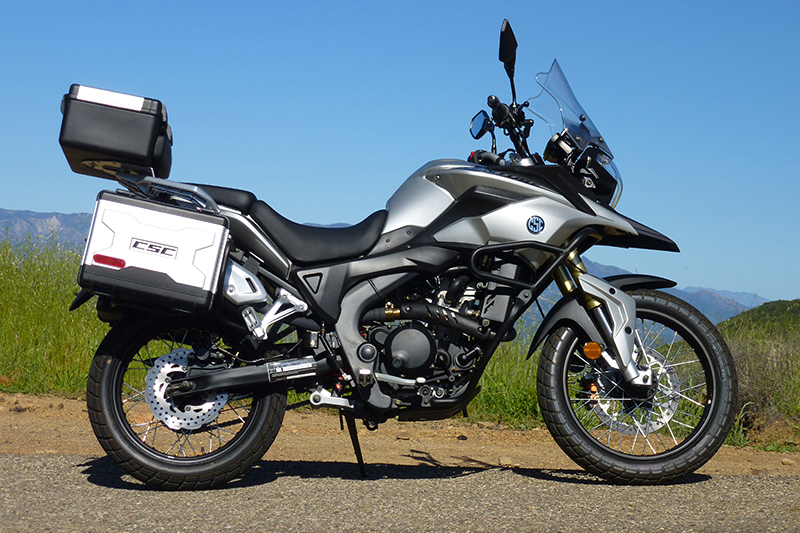2016 CSC RX3 Adventure

Road Test Review
My first “adventure tour” was a three-day ride into the backcountry on a Yamaha 175 Enduro, decades ago. From that brief introduction, I discovered two things: missing a corner can leave you upside down in a bush, and that it’s the experience, not the size of the bike, that makes a ride an adventure. Through a series of larger and larger dual-sports over the years, that second lesson faded away. It was refreshed three years ago at a remote gas stop in Argentina, when I spoke with a fellow American traveling by motorcycle. My ride was a rented BMW R 1200 GS, and his was a 150cc Chinese street bike he’d purchased in Bolivia. With daypacks bungeed to tank and seat, he headed south and was having the time of his life, wanting nothing to do with our Patagonia tour group’s big machines. Point taken.
With that in mind, here is the RX3 adventure tourer, powered by a single-cylinder 250cc mill. Small indeed. Built to CSC Motorcycles’ specs by Zongshen in China (they make a million motorcycle engines a year), the RX3 costs $3,895 delivered to your door (plus assembly and a crate fee) through CSC’s website. It’s a new business model for most of us, but CSC began selling Mustang motorcycle replicas that way in 2009. Emphasizing owner maintenance, the company provides service manuals, online tutorials, and, according to CSC’s Joe Berk, it stocks every part on the bike. If necessary, CSC will also coordinate warranty service with independent shops. They might even help you translate owner’s manual nuggets like this: “When adding fuel, make engine flameout first.”
While the fuel-injected RX3 doesn’t break any performance barriers, it does deliver solid performance from its liquid-cooled, SOHC, four-valve powerplant. The aluminum block engine rides in double downtubes suspended from a steel perimeter frame. Our RX3 took 1,250 miles of hard running from the Rider crowd in stride without using a drop of oil, and the twin radiators kept the coolant temperature in check throughout the test. Finding conflicting numbers for recommended fuel octane (89 owner’s manual vs. 91 emissions sticker), we asked CSC for guidance. It assured us that 87 PON or AKI is sufficient.
CSC claims a top speed of 84 mph for the RX3, which Editor-in-Chief Tuttle verified with GPS, though the speedo read a whopping 93. My own GPS check indicated more than a 10-percent error from an indicated 50-70 mph. For freeway or sporting use, expect to flirt with the 9,000 rpm redline frequently. Power is soft on the bottom and climbs steadily to a small surge around 7,000 rpm. The slick-shifting 6-speed transmission helped me stay in the powerband, with neutral the only position that was elusive. I commuted 100 miles a day on the RX3 at 8,000-8,500 rpm and it kept up with freeway traffic, though overtaking is best planned ahead. Still, I passed a Ducati Monster in the twisties on this bike. OK, Mr. T-shirt and jeans wasn’t a great rider, but the 250 had the spunk to slip by him on an uphill sweeper.
Though short on travel for an adventurer (5.1/5.6 inches front/rear), the suspension allows plenty of cornering fun. When the pavement ends, it’s time to chill. My dirt testing proved the RX3 capable of negotiating very rough roads as long as I didn’t push it too hard over the nasty stuff. The adjustments for rebound damping at both ends and spring preload at the rear won’t make up for limited travel. Wraparound crash bars provide front-end protection and the luggage racks protect the bags—as tested in a garage tipover—but added to our measured 408-pound wet weight (claimed is 385). The RX3’s low seat height makes that manageable for most riders. The wheels are wire-spoked steel hoops, with an 18-inch front rim (a 19-incher adds $199.95) and 17-inch rear. They carry dual-sport tires that gripped tarmac and terra firma well enough for our dry testing conditions. Braking is another matter, even with the 11.5-inch front rotor upgrade ($299.95, stock is 10.31 inches) on our test bike. Grabbing that disc is a two-piston caliper, with a single-piston unit at the rear; neither is outstanding, and the rear takes a good stomp to skid the tire. Used in concert they provide enough braking power for the 250 with a solo rider, though the front brake faded with hard use on a long, winding downhill.
Despite its counterbalancer, the Zongshen single vibrates noticeably. Rubber inserts in the serrated aluminum pegs and the thick seat damp it somewhat, leaving the bars the buzziest. The small windscreen is unobtrusive and effective at diminishing windblast, though it does focus the engine’s plentiful intake noise on the rider, especially when crouched over the tank. Zongshen fits a compact but readable LCD panel that provides the speedo, temp and gas gauges, gear position indicator and odometer/tripmeter. Two of the panel’s functions have notable shortcomings—the gas gauge cries wolf with around 2 gallons left in the 4.2-gallon tank, and the tiny indicator lights for turn signals and other notifications are invisible in daylight. Very visible is the analog tachometer and large, widely spaced mirrors that give an excellent rear view until blurred by vibration. Overall, the RX3’s ergos and seat made for a comfortable 435-mile day for this 5-foot-8-inch-tall rider.
There’s juice a-plenty for an adventurer’s electronics aboard the RX3, supplied by a 300-watt alternator (up from 220 watts) specified by CSC. It also added an outlet for a 12-volt cigar lighter/USB port accessory ($99.95) to help riders tap into the extra power. LED turn signals and a four-way flasher are nice touches, as are the grease fittings on the swingarm; missing is a side stand safety switch.
The CSC’s fit and finish is impressive, rivaling that of Japanese 250s that I’ve tested. And don’t mistake the RX3 for a toy—it’s a capable small-bore adventure bike, right down to its smallish lockable resin luggage (holding about 50 liters total) and other ADV attributes. Anyone intimidated by the height, weight or price of today’s adventure machines should take a close look at the RX3. Patagonia, anyone?

